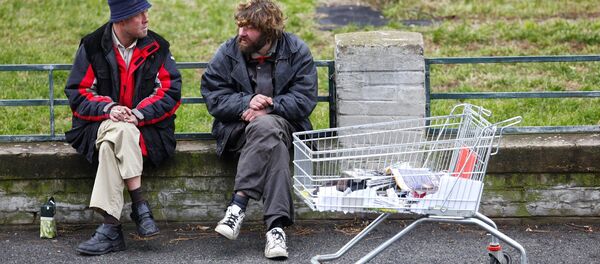Paradoxically, growing homelessness has followed rapid economic growth, as landlords raise rents, forcing many to move onto the street. Radio Sputnik discussed the issue with Los Angeles, California-based, housing advocate Tanya Tull.
A new federal study observes that over half a million people are homeless on any single night, adding that the number of homeless in New York has grown by over four percent in the past year alone.
On the west coast of the US, homeless populations in Seattle, Oakland, Portland and San Diego have risen. Many point to late-20th century moves by the Reagan administration in which federal investment in low-income housing was slashed.
Most people on the verge of homelessness do not receive any form of government assistance in the US, the study observed.
"The problem there is that a vast majority of homeless people are not living in the streets, they are not visible, they are not in shelter," said Tull, a founder of Partnering for Change, an organization finding stable housing for families with children.
Renting five rooms in one house for five different families is common, as it allows cheaper rent for all, but people who opt for these temporary measure are still, by definition, homeless.
Landlords in wealthy neighborhoods opt to raise rents as a means to increase cash flow, which forces people with fixed incomes out. Much of the recent successes on Wall Street are a form of economic growth that does not translate to incomes that can match the increases in the cost of living.
"The income gap between the rich and the poor has grown increasingly to the point that the middle class is slowly disappearing," Tull observed.
"City officials, homeless advocates and those living on the streets point to the main culprit: the region's booming economy," according to an AP report.
Rents have soared for many low-wage workers who until just a just few years ago could typically find housing. Now, even a temporary setback can be enough to leave them out on the street, the agency reported.
As incomes do not increase to match costs of living, a recent spike in homelessness signals an even greater increase of the potentially deadly social problem.
Tull pointed out that mid-20th-century moves in the US by the wealthy from the inner cities to the suburbs caused city authorities to renovate and upgrade affordable housing in an attempt to attract upper-class residents back to the inner city, particularly as a means of reclaiming lost tax revenue. As affordable housing disappears, people are forced onto the street.
Los Angeles Mayor Eric Garcetti said that insufficient federal funding for affordable housing and anti-homelessness programs are part of the reason for the city's current crisis.
"Los Angeles' homeless crisis was not created in a vacuum, and it cannot be solved by LA alone," Garcetti stated. LA city and the Los Angeles County have passed a pair of tax-boosting ballot initiatives to raise an $4.7 billion over the next decade for affordable housing and services for the homeless, although many suggest that the move is too little, too late.




